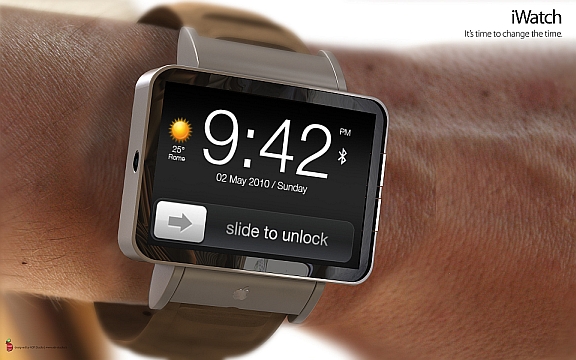Apple iWatch rumors have hit the mainstream, thanks to reports from both The New York Times’ Nick Bilton and The Wall Street Journal’s Jessica Lessin, with sources describing “curved glass” “watch-like” prototypes, potentially with components in production testing at Apple supply-chain partner Foxconn. But before you label a jar “Apple iWatch Reserve Fund” and start pinching your pennies, consider the likelihood that this kind of tech is coming to store shelves soon, if at all.
Here’s the thing: Apple builds stuff all the time. Literally all the time they’re working on things, including the fabled Apple television set that has made Gene Munster’s predictions one of the longest current running jokes in the tech industry today. Would Apple build a wearable computer prototype? Given the success of iPod nano wristwatch case accessories, given the unprecedented crowdfunding of the Pebble smart watch, given Google’s clear and present interest in wearable tech with Google Glass, the answer is “of course.” But to build and to ship are two entirely different things, and Apple often does the former, but only selectively continues through to the latter.
There are still some major hurdles standing in the way of a shipping iWatch, and these are barriers that aren’t likely to be overcome in, say, the next few years. For evidence of what’s wrong with the idea of an imminent iWatch, you need only look at the market equivalents that currently exist.

The MetaWatch and the Pebble, two Kickstarter success stories that have actually made it to market, both have considerable limitations as practical devices. Battery life is a major concern, and consistent functioning of basic services like email notifications is a problem. The fact that both of these projects are coming from companies with years of experience building smart watch devices isn’t reassuring, either – these problems seem like issues with first-generation prototypes, but they’re coming from companies that, in the case of the Pebble, have already shipped thousands of production units before now.
Apple could have some advantages over these makers, since it’ll have direct access to private iOS APIs should it build an iWatch, but the technology still doesn’t seem ready for practical application. No one wants to charge a watch with anywhere near the frequency currently required, no matter the brand behind it.
You could argue that Apple has a history of coming in and delivering a dramatically improved product where others have failed, which is exactly why it was able to build a compelling MP3 player with the iPod. But the smart watch industry isn’t like the others it has revolutionized. MP3 players needed saving; smartphones needed a shake-up; tablets were limping along. Smart watches, however, are still something for which there is negligible-to-no proven demand in the general consumer population, tech-head crowdfunders excepted. There’s no problem for Apple to fix here yet, in other words, and there may never be.
There’s no problem for Apple to fix here yet, and there may never be.
Apple could still surprise and deliver an iWatch experience that creates a demand where there was none before, as they have done in the past. Former Apple interface designer Bruce Tognazzini argued that in a blog post last week, but some of his main points actually explain precisely why we’re nowhere near seeing this ship. He suggests Apple has a wireless charging patent that would make charging less annoying, and offers Siri as a way to navigate a device with relatively small touch hit points and potentially fidgety controls. He also offers up NFC as a way for the iWatch to communicate for things like mobile payments, and talks about another patent for curved glass helping explain the form factor. Yet all of these things involve tech that Apple either has yet to implement, or has yet to implement well (in the case of Siri) in a shipping product.
Apple is a company that takes risks, but an iWatch would be an aggregate of risks with no precedent and little immediately apparent utility value. I have little doubt that it isn’t in the R&D lab at Cupertino right now, but if you’re getting your hopes up for a street date, you might want to hibernate for another few years. I’ll wake you when it’s here.
